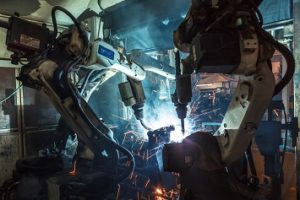What workplace safety and health issues are looming for the manufacturing sector? We can get an idea as to where environment, health, and safety (EHS) professionals should focus their efforts by taking a look at the new draft research agenda recently issued by the National Institute for Occupational Safety and Health (NIOSH).
NIOSH has six objectives in researching workplace issues for the manufacturing sector. Your facility could be affected by one or all six of them. Let’s take a look.
Objective 1. Reduce workplace illnesses, injuries and fatalities in manufacturing by enhancing knowledge of hazards and their effects and developing effective interventions to reduce exposure.
NIOSH claims that new technologies and employment arrangements in manufacturing call for new knowledge for prevention and exposure control, especially for small businesses. To that end, NIOSH has four sub-objectives:
- Reduce traumatic injuries and fatalities. One of the concerns here is robots. According to NIOSH, there will be 1.4 million new industrial robots in factories worldwide before the end of 2019. There will be an increase in robots designed to work alongside humans. NIOSH investigators see an increasing prevalence of traditional industrial robots contributing to more deaths and injuries of workers when existing control strategies are not used. In addition, newer types of robots may introduce unforeseen hazards.
- Reduce chronic diseases. NIOSH will be looking at exposures that contribute to respiratory diseases, occupational cancer, heart disease, neurological diseases, and adverse reproductive outcomes. In terms of respiratory diseases, the biggest concerns in manufacturing are chronic obstructive pulmonary disease, work-related asthma, and work-related interstitial lung diseases. Exposures of concern include beryllium, respirable silica, and elongated mineral particles. Researchers will be looking at adverse reproductive and developmental effects that arise in manufacturing settings through the use of such toxicants as heavy metals and organic solvents. In addition, NIOSH is particularly concerned about welding fumes and the exposure of welders to manganese.
- Reduce MSDs. According to NIOSH, there were 41,000 severe musculoskeletal disorder (MSD) injuries in manufacturing in 2015. NIOSH researchers will be looking into the effects of mechanization on the development of work-related MSDs; revising existing risk assessment tools to account for increased task variability in a work shift; and developing ergonomic interventions that take into account changing workloads and risk exposures.
- Reduce hearing loss. While hearing loss has been declining in prevalence, NIOSH wants to look into risk factors, including age; new hearing protection technologies; and the effectiveness of prevention efforts.
Objective 2. Improve surveillance of workplace hazards. NIOSH claims that new technological approaches need to be developed to identify, measure, and track illnesses for which workers in manufacturing are most at risk. They want to explore variables including industry and occupation and other metrics in Electronic Health Records. NIOSH researchers also want to develop a standardized approach to estimating the risk of manufacturing job hazards.
Note. If you have any concerns about the Draft National Occupational Research Agenda for Manufacturing, you must submit your comments by October 23, 2017. Go to http://www.regulations.gov, and enter CDC-2017-0072, NIOSH 300 in the search box.
Check tomorrow’s Advisor for a look at the other four objectives in NIOSH’s new Draft National Occupational Research Agenda for Manufacturing.

